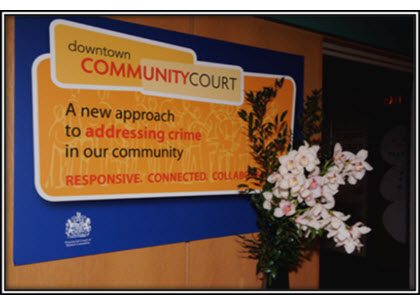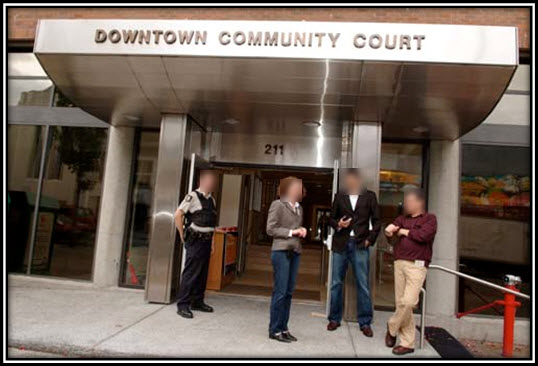Vancouver’s downtown eastside is an area is known for open drug use, aggressive panhandling, and a host of other disorderly behaviour. The number of people with addictions and mental illness is visible to any passerby. It is a neighbourhood in flux, under pressure from the competing push for both luxury and social housing, and for its increasing appeal as a location for businesses including technology, coffee shops, breweries, tourism and a wide range of social services. How does the BC Provincial Court work with this lively community to improve things?
In 2005 a Street Crimes Working Group struck to find better ways to respond to chronic, low level offenders and the “revolving door” sometimes seen in the court system recommended establishment of a community court. Consisting of judges, lawyers, police officers, representatives of BC Corrections, Forensic Psychiatric Services, Vancouver Coastal Health and the Ministry of Children and Family Development, the Working Group recommended a community-based court with “wrap around” services.

As a result, the Provincial Court worked with the provincial government and other partners to create Downtown Community Court, a criminal bail and sentencing court, with the goal of reducing harm caused to the community from unlawful acts. Operating since 2008 out of a renovated jail at 211 Gore Avenue in Vancouver’s Downtown Eastside, the Community Court works to achieve this goal by providing sanctions, services and interventions to create a safer, more livable community and by fostering a sense of responsibility in offenders.
The Community Court takes a problem solving approach, addressing offender’s needs, circumstances and the underlying causes of their criminal behaviour. To accomplish this it depends on partnerships, and works in collaboration with 14 outside agencies including community-based non-profits. The Court has forged new co-operative relationships, both within the justice system and with health and social service agencies, community organizations, area residents, merchants, the faith community and schools.
Judge Elisabeth Burgess, currently the primary judge at the Downtown Community Court, shared these reflections on her work.
“As a judge at this court, I hear things every day that speak of hardship, incredible challenges, and also of resilience and kindness. I hear of programmes put together by staff here, with creativity and resourcefulness, to address needs of people who need help the most.

Every day I hear the stories of people’s lives. I sometimes think the single most important thing a judge can do is listen. What you hear can change your way of thinking. Of course, judges have to filter what they hear to sort out what is true from what is not true. We must try to tell the difference between someone who is just nervous about being in court, or is someone completely untrustworthy, who has their back against the wall and will say anything.
But there are times when you just hear the story of a person’s life, unadorned facts that rock you. These stories emerge at Downtown Community Court every day. These stories are sometimes so shocking; they make me think about why some people might need to self medicate. You may have passed some of these people on the street, maybe high on drugs, maybe angry and shouting, or maybe just sleeping on the sidewalk in oblivion.
What I hear in court helps me to understand how they got there. This does not necessarily excuse their offences, but it is always helpful in crafting the appropriate sentence in each case.”
For example, one Community Court client was a 23 year old who had recently entered the court system after being charged with some relatively minor, non-violent offences and being placed on several bail orders. As a child he had been placed in foster care because his mother was a serious addict and his father left them. He spent time in 17 foster homes in a two and a half year period, and had been on the streets since the age of 14. He now had a heavy addiction and was recently diagnosed with a significant mental illness.
The hope for this young man was that he might be connected to services that would help him with housing, psychiatric care and addictions. Each time he appeared in court he asked for help and appeared motivated to tackle his addictions. Although his story so far was sad, everyone who worked with him was driven by the hope that he would have a better future.
When he appeared in Downtown Community Court he was given a chance to work with the Court’s Mental Health Team. The Judge explained that he would get the intensive supervision he needs, they would help connect him to services, help him find housing so he would not have to live on the streets, and connect him to services such as a community mental health program and to the psychiatrist who works with the Court’s clients. The young man agreed, and with the support of the Mental Health Team has been connected to the help he needs. He no longer feels he is on his own with his problems. He has not had any more criminal charges since joining the Team.

Offenders repay the community through community service
Downtown Community Court has been evaluated twice. It has shown a significant decrease in recidivism for offenders like this who engage in its integrated Case Management and Mental Health Programs, as well as significant positive client outcomes regarding housing and attachment to community services. For evaluation reports and more information on this and other Provincial Court specialized courts, see Specialized Courts.
First photo credit: http://www2.gov.bc.ca/gov/content/justice/criminal-justice/vancouver-dow...

